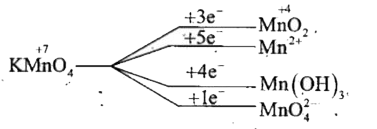Number of electrons transferred in each case when KMnO4, acts as an oxidising agent to give MnO2,Mn2+2,Mn(OH)3,MnO2−4 are respectively:Solution in Malayalam
3, 5, 4 and 1
4, 3, 1 and 5
1,3,4 and
5, 4, 3 and 1
The correct Answer is:A
Topper's Solved these Questions
- BOOK - BRILLIANT PUBLICATIONCHAPTER - THE D- AND F-BLOCK ELEMENTEXERCISE - LEVEL-II (ASSERTION-REASON TYPE)40videos
THE D- AND F-BLOCK ELEMENT
- BOOK - BRILLIANT PUBLICATIONCHAPTER - THE D- AND F-BLOCK ELEMENTEXERCISE - LEVEL-II (ASSERTION-REASON TYPE)40videos
THE D- AND F-BLOCK ELEMENT
- BOOK - BRILLIANT PUBLICATIONCHAPTER - SURFACE CHEMISTRY EXERCISE - QUESTIONS (LEVEL - II) (ASSERTION REASON TYPE QUESTIONS)6videos
SURFACE CHEMISTRY
- BOOK - BRILLIANT PUBLICATIONCHAPTER - THE D-AND F-BLOCK ELEMENTSEXERCISE - QUESTIONS (LEVEL-III)50videos
THE D-AND F-BLOCK ELEMENTS
Similar Questions
Assertion : Zn, Cd and Hg are not considered as transition metals.
Reason :d-orbitals in Zn, Cd and Hg are completely filled, both in ground state and in their available oxidation states.02:16View SolutionAssertion : Zn, Cd and Hg are not considered as transition metals.
Reason :d-orbitals in Zn, Cd and Hg are completely filled, both in ground state and in their available oxidation states.02:25View SolutionAssertion: Enzymes are proteins and enzyme catalysed reactions are called biological catalysis.
Reason: The activity of enzyme catalysis increase in presence of vitamins.04:52View SolutionA metal M which is not affected by strong acids like conc. HNO3 conc. H2SO4 and concentrated solutions of alkalies like KOH and NaOH but dissolves in aqua-regia and forms MCI3 which is used for toning in photography. The metal M is:
02:16View SolutionWhen KMnO4 acts as an oxidising agnet and ultimetely from MnO2−4,MnO2,Mn2O3, and Mn2+, then the number of electrons transferred in each case, respectively, are
02:16View SolutionNumber of electrons transferred in each case when KMnO4 acts as an oxidising agent to give MnO2,Mn2,Mn(OH)3 and MnO2−4 are respectively:
02:16View Solutionजब KMnO4 ऑक्सीकारक की भाँती कार्य करता है तथा अंततः [MnO4]2−,MnO2,MnO3 तथा Mn2+ बनाता है , तब प्रत्येक दशा में स्थानान्तरित एलेक्ट्रॉनों की संख्या है :
08:32View SolutionWhen KMnO4 acts as an oxidising agnet and ultimetely from MnO2−4,MnO2,Mn2O3, and Mn2+, then the number of electrons transferred in each case, respectively, are
View SolutionWhen KMnO_(4) acts as an oxidising agent and ultimately forms MnO_(4)^(-2),MnO_(2),Mn_(2)O_(3) and Mn^(+2) then the number of electrons transferred in each case respectively is
01:24View SolutionWhen KMnO_(4) acts as an oxidising agent and ultimately forms MnO_(4)^(-2),MnO_(2),Mn_(2)O_(3) and Mn^(+2) then the number of electrons transferred in each case respectively is
02:08View SolutionNumber of electrons transferred in each case when KMnO4 acts as an oxidising agent to give MnO2,Mn2+,Mn2(O)3andMnO2−4 respectively are :
02:12View Solutionwhen KMnO4 acts as an oxidizing agent and ultimatcly forms MnO2−4,MnO2,Mn2O3andMn2+ then the number of electrons transferred in each case respectivelty is
02:45View SolutionNumber of electrons transferred in each case when KMnO4 acts as an oxidising agent and converts into MnO2,Mn2+,Mn(OH)3 and MnO−2 are respectively
02:39View SolutionWhen KMnO_4 acts as an oxidizing agent and ultimately forms MnO_(4)^(2-), MnO_2, Mn_2O_3 and Mn^(2+) . The number of electrons transferred in each case respectively is
03:13View SolutionWhen KMnO4 acts as an oxidising agnet and ultimetely from MnO2−4,MnO2,Mn2O3, and Mn2+, then the number of electrons transferred in each case, respectively, are
04:15View Solution


